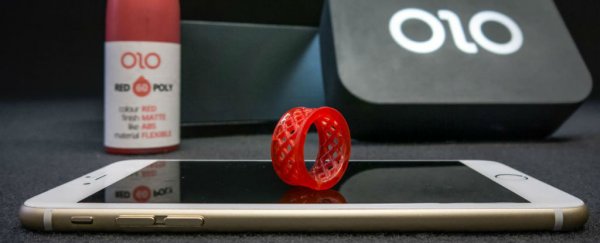We keep hearing about the awesome applications of 3D printers, such as home-made braces (don't actually try at home), toys, Terminator-style creations that rise from molten plastic baths, and, you know, human ears, but despite the technology being cheaper and more accessible than ever, you probably don't have too many people in your life (if any) who actually use a 3D printer for real.
Well, if devices like the OLO are anything to go on, that could all be about to change. The OLO is a $99 gadget that lets you turn any smartphone into a 3D printer, and uses the light from the touchscreen to process your plastic creations.
The whole thing is designed to be super-simple to understand and operate, and is battery-operated and fully portable, weighing just 780 grams (1.7 lb) and measuring 17.2 x 11.5 x 14.8 cm (6.8 x 4.5 x 5.8 inches).
It consists of three parts: a reservoir, which holds 400 cubic cm of printing volume; 100-gram bottles of coloured photopolymer resin to build your objects with; and a mechanised lid, under which the build plate and control electronics are tightly arranged.
So how do you use it? First, you have to load a schematic of your object into the OLO mobile app (available for iOS, Android, and Windows) and then fit your smartphone into the base under the reservoir. A piece of polarised glass is installed into the base, which your phone's touchscreen will be facing when set in place. Even the large iPhone 6S+ will apparently fit.
Then comes the printing part, which Drew Prindle explains over at Digital Trends:
"Basically, once you place the lid on top and the printer starts going, the app makes your phone's screen light up with a specific pattern. The polarised glass then takes all this light (which shines outwardly to give your phone a wider viewing angle) and redirects it so that all the photons are travelling straight upward.
So as your phone's screen beams light up into the reservoir, the directed light causes a layer of resin to harden onto the build plate, which slowly moves upward as each new layer is created."
Prindle adds that it uses the same basic functions as a Digital Light Projection (DLP) printer, but replaces the big, very expensive projector with your smartphone screen.
The team behind the technology has also developed an entirely new type of resin to use with the OLO. Called 'daylight resin', it's been specifically designed to react to the white light that our smartphone screens emit.
As Stanley Goodner reports for Gizmag, specific 'pixels' of the resin will be exposed to the smartphone light for a certain amount of time to transform it from a liquid to a solid, and your object is built pixel by pixel, layer by layer.
"Users have the option to create designs that are hard, flexible, fusible, flexy, or elastic, mimicking familiar substances of PMMA, ABS, hard wax, soft PVC, and silicon," says Goodner. "The OLO mobile app calculates the necessary amount of resin required per print in order to minimise/eliminate waste."
The gadget is currently being funded on Kickstarter, but has apparently smashed its US$80,000 goal already.
According to Gizmag, it raised 507 percent of its $80,000 goal in two days, and there are still 28 days left of the campaign, so it looks like this thing is going to be popular.
First shipments of the OLO are expected to start in September.

